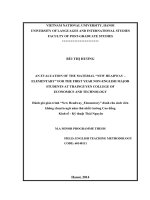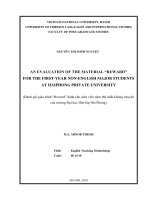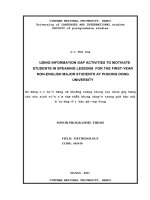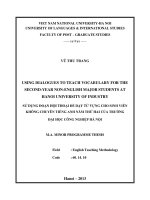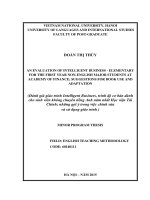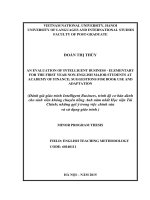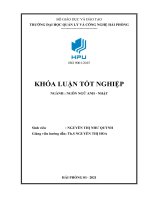Khóa luận how to improve reading skill for the final year of english major students at HPU
Bạn đang xem bản rút gọn của tài liệu. Xem và tải ngay bản đầy đủ của tài liệu tại đây (0 B, 48 trang )
BỘ GIÁO DỤC VÀ ĐÀO TẠO
TRƯỜNG ĐẠI HỌC QUẢN LÝ VÀ CƠNG NGHỆ HẢI PHỊNG
-------------------------------
ISO 9001:2015
KHĨA LUẬN TỐT NGHIỆP
NGÀNH : NGÔN NGỮ ANH - NHẬT
Sinh viên
: NGUYỄN THỊ NHƯ QUỲNH
Giảng viên hướng dẫn: Th.S NGUYỄN THỊ HOA
HẢI PHÒNG 01– 2021
BỘ GIÁO DỤC VÀ ĐÀO TẠO
TRƯỜNG ĐẠI HỌC QUẢN LÝ VÀ CƠNG NGHỆ HẢI PHỊNG
-----------------------------------
HOW TO IMPROVE READING SKILL FOR THE FINAL
YEAR OF ENGLISH MAJOR STUDENTS AT HPU
KHÓA LUẬN TỐT NGHIỆP ĐẠI HỌC HỆ CHÍNH QUY
NGÀNH: NGƠN NGỮ ANH - NHẬT
Sinh viên
: NGUYỄN THỊ NHƯ QUỲNH
Giảng viên hướng dẫn: ThS. NGUYỄN THỊ HOA
HẢI PHÒNG 01 – 2021
BỘ GIÁO DỤC VÀ ĐÀO TẠO
TRƯỜNG ĐẠI HỌC QUẢN LÝ VÀ CƠNG NGHỆ HẢI PHỊNG
--------------------------------------
NHIỆM VỤ ĐỀ TÀI TỐT NGHIỆP
Sinh viên: Nguyễn Thị Như Quỳnh
Lớp:
NA1902N
Ngành:
Ngôn Ngữ Anh - Nhật
Mã SV: 1512753024
Tên đề tài: How to improve reading skill for the final year of English major
students at HPU
NHIỆM VỤ ĐỀ TÀI
1. Nội dung và các yêu cầu cần giải quyết trong nhiệm vụ đề tài tốt nghiệp
………………………………………………………………………………….
………………………………………………………………………………….
………………………………………………………………………………….
………………………………………………………………………………….
………………………………………………………………………………….
………………………………………………………………………………….
2. Các tài liệu, số liệu cần thiết
………………………………………………………………………………….
………………………………………………………………………………….
………………………………………………………………………………….
………………………………………………………………………………….
………………………………………………………………………………….
………………………………………………………………………………….
………………………………………………………………………………….
………………………………………………………………………………….
………………………………………………………………………………….
3. Địa điểm thực tập tốt nghiệp
………………………………………………………………………………….
CÁN BỘ HƯỚNG DẪN ĐỀ TÀI TỐT NGHIỆP
Họ và tên
:
Học hàm, học vị
:
Cơ quan công tác
: Trường Đại học Quản lý và Cơng nghệ Hải Phịng
Nội dung hướng dẫn:
Đề tài tốt nghiệp được giao ngày
tháng
Yêu cầu phải hoàn thành xong trước ngày
năm 2020
tháng
năm 2020
Đã nhận nhiệm vụ ĐTTN
Đã giao nhiệm vụ ĐTTN
Sinh viên
Giảng viên hướng dẫn
HảiPhòng, ngày
tháng
TRƯỞNG KHOA
năm 2021
CỘNG HÒA XÃ HỘI CHỦ NGHĨA VIỆT NAM
Độc lập - Tự do - Hạnh phúc
PHIẾU NHẬN XÉT CỦA GIẢNG VIÊN HƯỚNG DẪN TỐT NGHIỆP
Họ và tên giảng viên:
...................................................................................................
Đơn vị công tác:
........................................................................ ..........................
Họ và tên sinh viên:
.......................................... Chuyên ngành: ...............................
Nội dung hướngdẫn:
.......................................................... ........................................
............................................................................................................................
Tinh thần thái độ của sinh viên trong quá trình làm đề tài tốt nghiệp
............................................................................................................................
..............................................................................................................................................
..............................................................................................................................................
..............................................................................................................................................
..............................................................................................................................................
1.
Đánh giá chất lượng của đồ án /khóa luận (so với nội dung yêu cầu đã đề
ra trong nhiệm vụ Đ.T. T.N trên các mặt lý luận, thực tiễn, tính tốn số liệu…)
..............................................................................................................................................
..............................................................................................................................................
..............................................................................................................................................
..............................................................................................................................................
..............................................................................................................................................
..............................................................................................................................................
..............................................................................................................................................
3. Ý kiến của giảng viên hướng dẫn tốt nghiệp
Được bảo vệ
Không được bảo vệ
Điểm hướng dẫn
Hải Phòng, ngày … tháng … năm ......
Giảng viên hướng dẫn
(Ký và ghi rõ họ tên)
QC20-B18
CỘNG HÒA XÃ HỘI CHỦ NGHĨA VIỆT NAM
Độc lập - Tự do - Hạnh phúc
PHIẾU NHẬN XÉT CỦA GIẢNG VIÊN CHẤM PHẢN BIỆN
Họ và tên giảng viên:
..............................................................................................
Đơn vị công tác:
........................................................................ .....................
Họ và tên sinh viên:
...................................... Chuyên ngành: ..............................
Đề tài tốt nghiệp:
......................................................................... ....................
.................................................................................................................................
.................................................................................................................................
1. Phần nhận xét của giáo viên chấm phản biện
..........................................................................................................................................
..........................................................................................................................................
..........................................................................................................................................
..........................................................................................................................................
..........................................................................................................................................
..........................................................................................................................................
2. Những mặt còn hạn chế
.................................................................................................................................
..........................................................................................................................................
..........................................................................................................................................
..........................................................................................................................................
..........................................................................................................................................
..........................................................................................................................................
3. Ý kiến của giảng viên chấm phản biện
Được bảo vệ
Không được bảo vệ
Điểm phản biện
HảiPhòng, ngày … tháng … năm ......
Giảng viên chấm phản biện
(Ký và ghi rõ họ tên)
QC20-B19
TABLE OF CONTENTS
ACKNOWLEDGEMENTS
PART A : INTRODUCTION ............................................................................. 1
1. Rationale............................................................................................................ 1
2 .Aim of the study ................................................................................................ 3
3 .Scope of the study ............................................................................................. 3
4. Methods of the study ......................................................................................... 3
5 .Significance of the study ................................................................................... 4
6. Organization of the study .................................................................................. 4
PART B : DEVELOPMENT.............................................................................. 6
CHAPTER 1 : THEORITICAL BACKGROUND .......................................... 6
1.1. The difinition of reading . .............................................................................. 6
1.1.1. What is reading ? ......................................................................................... 6
1.1.2. The purpose of reading ............................................................................... 6
1.1.3. Differences between reading and spoken language . .................................. 7
1.2 . Reading Skill . ............................................................................................... 8
1.2.1 Skimming ..................................................................................................... 8
1.2.2.Scanning ....................................................................................................... 9
1.2.3. Previewing ................................................................................................. 10
1.2.4. Predicting the content . .............................................................................. 12
1.2.5. Predicting the new words in the context . ................................................. 13
1.3.Type of reading . ........................................................................................... 13
1.3.1 .Extensive reading ...................................................................................... 13
1.3.2. Intensive reading ....................................................................................... 14
CHAPTER 2 : SURVEY QUESTIONAIRE .................................................. 16
2.1 .Participant and purpose of the survey and questionaire............................... 16
2.1.1 Participants ................................................................................................. 16
2.1.2. Purpose of the survey questionnaires :..................................................... 16
2.1.3 Design of questionaire............................................................................... 17
2.2 . Data and analysis ........................................................................................ 20
2.2.1 Student’s real situations of learning English reading skill. ....................... 20
2.2.2.How long have you been learning English ? ............................................. 21
2.2.3. Do you like English reading lessons at class ?.......................................... 22
2.2.4. What do you think about the importance of English reading skill ?......... 23
2.2.5. What is your problem in reading skill ? .................................................... 24
2.2.6. Which of the following reasons make you difficult to learn English
reading ? .............................................................................................................. 25
2.2.7. What reasons reading activities do you like most ? .................................. 26
2.2.8. How much time do you spend on studying reading skill ? ....................... 27
CHAPTER 3 : SUGGESTIONS TO IMPROVE THE READING SKILL
FOR THE FINNAL YEAR ENGLISH MAJOR STUDENT AT HPU ....... 28
3.1. Extensive reading : ....................................................................................... 28
3.1.1.How to Improve Reading Comprehension: ............................................... 28
3.2. Five reading comprehension . .................................................................... 32
3.2.1: Stop When You Get Confused and Try to Summarize What You Just Read
............................................................................................................................. 32
3.2.2: If You're Struggling, Try Reading Aloud .................................................. 32
3.2.3: Re-read (or Skim) Previous Sections of the Text ...................................... 33
3.2.4: Skim or Read Upcoming Sections of the Text ........................................... 33
3.2.5: Discuss the Text With a Friend (Even an Imaginary Friend) .................. 33
3.3. Exercises : .................................................................................................... 34
PART C : CONCLUTION ............................................................................... 37
1. Summary . ....................................................................................................... 37
2. Limitations . .................................................................................................... 37
3. Recommendations for further study . .............................................................. 38
ACKNOWLEDGEMENTS
First of all , I would like to express my sincere thank to Hai Phong
Management and Technology University , an ideal environment , which gave
me the chance to learn and practise during the last 4 years .
A complete study would not be done without any assistance. I would like
to express my sincere thanks to Mrs.Nguyen Thi Hoa ,my supervisor. This thesis
could have probably not completed without her patient , enthusiastic and
instructive supervision and encouragement . I used to have many difficulties
during my research but my supervisor always stood by me and supported me .
Besides ,I want to give my sincere thank all the teachers in Foreign
Language Department of Hai Phong Management and Technology University
who helped me with the preparation of all my knowledge today.
I would like to thank my friends at class NA1902N for their helps and
giving me motivation to complete this graduation papar .
Last but not least , I would like to give my heartfelt thanks to my family .
Without their helps and supports , I can not finish this graduation paper well.
PART A : INTRODUCTION
1. Rationale.
It could not be denied that English language in the whole world has
become more and more important. English even becomes the international
language, is used in many countries in a popular way and is the mother tongue
of many countries over the world. In fact, English is the native language of
more than 350 million people .English is primary language.Therefore ,it is
easy to understand why most economical ,cultural, financial associations
have English name ; also why all enterprises, companies require employees’
foreign languages especially English . And the reality solves this. English
becomes one of main subject in almost school in the world .
Among the four language skills, reading is possibly the most
extensively and intensively studied skill by experts in the field of language
teaching. The results of the studies conducted for many decades on the nature
of reading how people learn to process textual information have contributed
contrasting theories about what works best in the teaching of reading. As a
result, language educators should choose among a wide variety of teaching
methods and techniques for students learning to read in their second language
(SL) or foreign language (FL).
For students who are learning English in an SL/FL context, reading is
the most crucial skill to master due to several reasons. According to Harmer
(2007), reading is crucial because of two main reasons. First, it is beneficial to
the students’ personal life. Reading English texts may have a positive impact
on students´ further studies and carriers or it may simply play the role of
joyful reading. Second, it is beneficial to their language acquisition for
reading improves students´ writing abilities, spelling and vocabulary
knowledge.
1
Realizing how crucial reading is for our students, we can see the great
importance of developing their reading ability. To achieve it, we should
improve our reading lessons by implementing the best method and techniques
provided by theories. This article aims to describe principal theories of
reading and examine some tips and guidelines for implementing a theory of
reading which will help us develop our learner’s abilities.
You probably know that even in your own language reading is regarded
as important because it can be entertaining and educational , can open up new
worlds and enrich your life , and improve hand -eye co-ordination and
enhance social skills.
But for learning a foreign language , in this case English , reading in
that language has additional important benefits that can help you learn the
language faster and more completely .
Reading is an essential skill for language learners .When your reading
skills improve , your listening, speaking and writing skills improve too.
In the process of teaching and learning English as a foreign language in
Vietnam in general, and at Haiphong Management and Technology
University (HPU) in particular, reading has always been paid a great deal of
attention from both teachers and students. Like many other universities in
Vietnam, English at HPU is learnt and taught in a non-native environment,
therefore, reading is not only considered as a means to gain knowledge but
also a means by which further study takes place. For the final year of English
major students although they have been learning English for at least several
years, it is still often difficult for them to understand text or a passage in
English, since they still lack of vocabulary, grammar, reading skills and poor
background knowledge. Besides, the teachers sometimes have to face with
difficulties in dealing with the students’ learning demand and newly
introduced sources of materials. In addition, teaching methods and teaching
techniques in general, are still below the international standard of education.
2
Therefore, identifying the methods to motivate students to learn English
reading skill is necessary. It is hoped that the study will make some
contributions to improve learning English in general, and reading in particular
among the final year of English majors at HPU. The author also hopes that it
will be possible to make useful suggestions for the teachers to improve the
situation of teaching and learning English reading at HPU.
2 .Aim of the study
As an English department student, the main purpose of this study is to
identify the majors causes of difficulties reading skill by first-year English
majors students at Haiphong Management and Technology University.
Besides, the study is expected to suggest some solutions to improve reading
skill for students. In order to gain this aim, the specific objectives of the study
are:
Firstly, the study focuses on the theory related to reading skill, the
awareness of the importance of reading and learning reading methods.
Secondly, the study explores the real situation and problems which
students have to encounter in learning reading.
Finally, the main purpose of this study is to suggest some effective and
productive methods that can be applied and suited for first year English
majors students at Haiphong Management and Technology University.
3 .Scope of the study
The present study focuses on improving the final year English majors’
reading skill at HPU. In fact, there are lost of various techniques to study
English reading .However , there are many different material resources and
researches while the author’s personal experience is limited . Therefore in this
graduation article , I would like to focus on finding out some solutions for
improving reading skill for final year student of HPU .
4. Methods of the study
The study is carried out on the basic of qualitative and quantitative
research methods including questionnaires and class observation.
3
Questionnaires are designed as a means to make the researcher’s evaluation
more objective. The questionnaires are given to the first year students at HMTU
with the hope to find out the causes of difficulties in reading skill by them and
some suggested solutions to their difficulties.
Analyzing statistics from the survey questionnaires on reading activities is
conducted with the cooperation of both teachers and students at HMTU. All
comments, remark recommendation assumptions, and conclusion provided in
the study are based on the data analysis.
Besides, more information needed for the study is gathered through other
methods such as informal interviews and discussions with teachers and students
at HMTU.
5 .Significance of the study
The result of this expected to be useful for:
First one , help Students :
To motivate and make enthusiasm the students in the learning process especially
in reading teaching and helpful for students will be able to create more
enjoyable and meaningful learning.
Second ,help teachers :
This method makes the teacher easy in teaching reading and this expect to give
useful contribution in teaching reading and give another way for the teacher
develop student’s reading.
Third , help school HPU :
This research useful to improve the quality of education and develop English
language teaching of the school
Finally , help researcher :
The researcher will improve his knowledge in teaching reading method and have
experience in observation and apply with classroom action research at school.
6. Organization of the study
The research work has three main parts :
4
Part A
-
Introduction provides ratonale , the aims , scope , methods ,
significance and organization of the study
Part B - Development consists of three chapters :
Chapter 1 : Theoritical Background
Chapter 2 : Survey questionaire
Chapter 3 : Suggestions to improve the reading skill for the final
year English major student at HPU .
Part C - Conclusion summarizies what is given in previous chapters and
limitation of the study as well as recommendations for further study .
5
PART B : DEVELOPMENT
CHAPTER 1 : THEORITICAL BACKGROUND
1.1. The difinition of reading .
1.1.1. What is reading ?
Reading is a receptive skill - through it we receive information. It is the
process of looking at a series os writing symbols and getting meaning from
them so that understanding the author’s massages. There are so many definitions
of reading that cause much confusion. Traditionally, reading is a passive
activity, but in fact, it should be active. According to Block (1992:319-343)
mentions that “reading is such a hidden process that is often unnoticed in the
language classroom. Teachers often believe that reading classes should be
teacher – centered”.
Reading means "reading and understanding", is a foreign language
student says ‘I can read it but I do not know what it means' this still does not
reflect the true meaning of the word read. According to William (1984):
“The role of reading when learning a foreign language is as follows:
learners are able to practice language that they have encountered through
listening and speaking; language gained from reading can be reused in writing,
or learners can learn how to make sense of text in order to get right information
for them.”
Reading is the process of constructing meaning from written texts. It is a
complex skill requiring the coordination of a number of interrelated sources of
information.
From the opinions above, the writer come to summary that reading is
process to understand the massages available in the text. In other words, reading
is process of getting meaning intended by the author from written information.
1.1.2. The purpose of reading .
Reading is a mental process. There are many definitions of reading.
Reading is when someone looks into a written text and starts to absorb the
6
information from the written linguistic message. In Longman Dictionary of
Applied Linguistic, reading is said as:
“Perceiving a written text in order to understand its contents. This can
be done silently (silent reading). The understanding that result is called reading
comprehension. ’’
Reading is an interactive , Brunan W.K (1989) for instance defines
reading as a two way interaction in which information is exchange between the
reader and the author”. Smith (1973) also shares the same attitude. This is
proved by his line:
“Reading is an act of communication in which information is transferred
from a transmitter to a receiver”
As for students, they define reading which cited from Jensen and Petty
(1918) as:
“where words go into your eyes and out of your mouth. They said that
books are written with many adventures and time and time again there are spots
where they say ‘I know it!’ it is interesting to them as they open the book, words
flow out and float across the mind”
In order for a person to be able to read, there is in need of other
skill to support the reader while reading. Reading is a mental process as
mentioned earlier so it needs other skills to be integrated with such as listening,
speaking and writing.
1.1.3. Differences between reading and spoken language .
* Reading and Speaking :
It comes without much debate to say that reading and speaking are both
important skills to have. We need both to communicate, but they do seem to be
different. After all, almost all people will learn to speak on their own, given
time. The same is not true of reading, and in fact, the majority of people
throughout history were illiterate. So, for a long time people assumed that these
two skills were not fundamentally connected. However, modern researchers are
questioning that idea. Now, it is believed that reading and speaking skills have a
7
reciprocal relationship. As one increases, so does this other. Reading improves
speaking skills, and speaking skills improve reading. Now, this is important for
early childhood education, but also for adults. See this guy? This is Juan
Estudia. He's a fully-grown, highly-educated adult from the fictional, virtual
country of Estudiantina, where they speak Estudiañol. So, he's just now learning
English, and how he learns to both speak and read will impact his success.
1.2 . Reading Skill .
It is necessary for the students to be aware of the purpose and goals for
reading a particular piece of written text. The important notice for both the
teachers and learners is that the purpose of reading related to the types of
reading skills. The subjects will attain their goals quickly and efficiently if they
apply appropriate reading skills. Kenneth Beare, an ESL trainer and developer,
points out that there are 4 main types of reading skills.
Skimming: reading rapidly for the main points.
Scanning: Reading rapidly to finda specificpieceof information.
Intensivereading:readingashorttextfordetailed information.
Extensive reading: reading a longer text, often for pleasure with
emphasis on overall meaning.
1.2.1 Skimming
Skimming differs from general rapid reading in that the readers go through
the text extremely quickly, merely dipping into it or sampling it at various
points. Skimming is the technique that is used widely in reading comprehension.
Skimming may sometimes be the prerequisite of reading for full understanding.
There are many definitions of skimming, Grellet (1981: 19) states that
“when skimming, we go through the reading material quickly in order to get the
gist of it, to know how it is organized, or to get an idea of the tone or intention of
the writer”. It means that the purpose of skimming is simply to see what a text.
Skimming occurs when the reader looks quickly at the contents page of a book,
or at the chapter headings, subheading, etc. This is sometimes called previewing.
Therefore, the key that actually encourages learners to skim is to give them a
8
series of texts and ask them to select appropriate titles from groups of ones.
Moreover, in order to teach skimming effectively, the teacher should have the
students read the beginning or end of a text or a paragraph because it may
provide students with a statement relating to the topic. Skimming gives students
the advantage of being able to predict the purpose of the passage, the main topic
or message, or possibly some of the developing or supporting ideas. This gives
them a “head start” as they embark on more focused reading. Skimming also
helps students organize their thoughts and specify what information they can get
from a book so that the subsequent reading will become more efficient.
In conclusion, skimming is understood as a necessary technique for
reading comprehension which enables readers to get the main points of the text
without being concerned with the details. Therefore, skimming should be
applied at the first stage of teaching reading to help student have an overview of
what they are going to read. And it is sure that they will understand the whole
text later. However, skimming sometimes proves too difficult for younger
learners, or beginners because they generally lack confidence and the knowledge
of the language they are learning.
1.2.2.Scanning
Like skimming, scanning is also one of two most valuable reading
strategies. However, scanning is far more limited than skimming since it only
means retrieving what information is relevant to our purpose. Scanning occurs
when a reader goes through a text very quickly in order to find a particular point
of information. It is a useful skill worth cultivating for its own sake, if it has
been cultivated systematically from the earliest point in the course at which it
can be attempted, co-operative work on the study of texts can be greatly
expected and made easy. Francois (1981: 19) understands that “when scanning,
we only try to locate specific information and often we do not even follow the
linearity of the passage to do so. We simply let our eyes wander over the text
until we find what we are looking for, whether it is a name, a date, or a less
specific piece of information”. With the same opinion, Mabel states that
9
“Scanning is the speed technique that helps you locate a bit of specific
information very rapidly. It could involve finding a name, date, place or
statistic. Or it might involve identifying a general setting in a short story.
Scanning is the technique you use when you read maps, charts, tables, or
graphs. It is the main skill researchers use when they examine various to locate
information about a specific topic”.
Scanning requires two skills of the reader. One of them is that they
recognize the specific type of word that identifies the item. The other is the use
of a different eye movement pattern, vertical vision. Nearly all the background
reading required for the presenting of a topic to the class by a group calls for
proficiency in this type of reading. There is a great range of text suitable for
canning – indexes, dictionaries, maps, advertisements, labels, reference material,
etc.
In short, the key to scanning is to decide exactly what kind of information
we can look for and where to find it. The purpose of scanning is to extract
certain specific information without reading through the whole text.
1.2.3. Previewing
Previewing is a pre-reading skill by which the reader tries to gather as
much information about the text as he/she can before reading it. The aim of
previewing is to find out what readers going to be reading before actually they
are read. Preview before read is to get an idea of what will find in the text.
Previewing a text mentally prepares readers to receive information from written
materials. This gathering of information helps the reader to have a general
picture of the text. Grellet (1996) defines that previewing is a very quick reading
technique to find out some information about a text. This technique involves
using the title of a text, the table of contents, the index, the appendix, the preface
of the author of publisher, headings or subtitles of chapters and paragraphs,
information on the back cover, acknowledgement, and so on. It is common for
students to dive into an academic text and begin reading in a hurry, which is
10
often counterproductive . hen reading for academic purposes, it is preferable to
read with certain goals in mind .
11
1.2.4. Predicting the content .
Predicting is an important reading strategy. It allows students to use
information from the text, such as titles, headings, pictures and diagrams to
anticipate what will happen in the story (Bailey, 2015). When making
predictions, students envision what will come next in the text, based on their
prior knowledge. Predicting encourages children to actively think ahead and ask
questions. It also allows students to understand the story better, make
connections to what they are reading, and interact with the text.
Making predictions is also a valuable strategy to improve reading
comprehension. Students are able to make predictions about a story, based on
what they have already heard, read, or seen. This in turn, will allow students to
become actively involved in the reading process. To determine if their
predictions are correct, students should be required to reread portions of the text
to recall facts about the characters or events within the story. Picture walks can
serve as a tool to organize information within a story, which can also increase a
child’s comprehension. During a picture walk, students are able to activate their
prior knowledge and connect the visual images in the story to their own personal
experiences.
Students can also use a graphic organizer to predict the outcome of a
story. They can do this by identifying clues within the text to predict how
characters will behave and how significant problems in the story will be solved.
When using a graphic organizer, students are able to stay fully engaged in the
story as they capture their thoughts in a logical way. It is important for teachers
to encourage children to record clues that either support or deny their
predictions. Teachers can also allow students to revise their predictions in order
to reflect on the clues that are found within the text.
Making predictions encourages readers to use critical thinking and
problem solving skills. Readers are given the opportunity to reflect and evaluate
the text, thus extracting deeper meaning and comprehension skills. Students will
12
also be more interested in the reading material when they connect their prior
knowledge with the new information that is being learned.
1.2.5. Predicting the new words in the context .
Predicting the meaning of the new words is the skill if guessing the
meaning of the words students encouter while the are reading. Students can
predict the meaning by reading the whole sentence, basing on the words before
and after the new word to figure out its real meaning. It is time consuming to
stop reading and look up dictonary, which can bore and slow down the reading
process. Basing on the context clue is very neccessary technique to help readers
read more effectively.
1.3.Type of reading .
1.3.1 .Extensive reading
Extensive reading is a fluency activity, mainly involving general
understanding. It provides valuable reinforcement of the language already
presented and practiced in the class as well as giving students useful practice in
inferring meaning from the context of the text.
Lewis and Hill (1985: 109) state that “extensive reading means students
have a general understanding of the text without necessarily understanding
every word”. It is obvious that when reading extensively, readers do not need to
have intense concentration on the content of a long text and total comprehension
because the objective of extensive reading is to cover the greatest possible
amount of text in the shortest possible time. In other words, extensive reading
can be compared to the activity of ploughing through the text in a uniform
fashion. Extensive reading is therefore regarded as means of entertainment and
pleasure. And the reason why this kind of reading is essentially needed is that it
can promote reading out of class. Students can read directly and fluently in the
foreign language for their own enjoyment without the aid of teacher.
Furthermore, it is by pursuing the activity of extensive reading that the volume
of practice necessary to achieve rapid and efficient reading can be achieved. It is
also one of the means by which a foreigner may be exposed to a substantial
13
sample of the language he may wish to learn without actually going to live in the
country to which that language is native.
Basing on the importance of extensive reading, Nuttall (1982: 168)
shows that “the best way to improve one’s knowledge of a foreign language is to
go and live among its speakers: The next best way is read extensively in it”.
The practice of extensive reading needs little justification. It is clearly
the earliest way of bringing the foreign learner into sustained contact with a
substantial body of English.
Broughton (1980: 111) suggests that “there appear to be basically three
ways the extensive reading may be encouraged, first by having class sets of title,
second by operating a class library system, and the third by using the school
library”.
In short, the kind of reading is necessary for students at University
because it actively promotes reading out the class and gives them opportunity to
use their own knowledge of the language for their own purposes. Moreover, this
kind of reading is regarded as pleasure and interest. That is why intensive
reading is highly motivated.
1.3.2. Intensive reading
The remaining two kinds of reading activity, content study reading and
linguistic study reading are also often grouped together and called intensive
reading.
Different from extensive reading – reading for fluency, readers can read
without the aid of the teachers and without understanding the text in detail –
extensive reading is regarded as reading for accuracy. It “involves approaching
the text under the close guidance of the teacher or under the guidance of a task
which forces the students to pay great attention to the text in order to arrive at a
profound to detailed understanding of the text not only of what it means, but
also of how the meaning is produced. The “how” is as important as the “what”,
for the intensive reading lesson is intended primarily to train students in reading
strategies”. (Nuttall, 1982: 23) .
14
Sharing this opinion, Lewis (1985: 109) states that “intensive reading
means students understand everything they read and be able to answer detailed
vocabulary and comprehension questions”. The concern of such reading is for
detailed comprehension of very short texts. “The objective of intensive readingis
to achieve full understanding of the logical argument, the rhetorical
arrangement or pattern of the text, of its symbolic, emotional and social
overtones, of the attitudes and purposes of the author, and of linguistic means
that he employs to achieve his ends” (Broughton, 1980: 93). In other words, the
aim of intensive reading is to obtain the fullest possible response in the student’s
head to the black mark in his book. Response cannot be achieved by instruction
about what he ought to see and feel, or by repetition of what others see and feel,
although knowledge of what can be seen by others sometimes helps us to see for
ourselves.
In general, in real life, our reading purpose constantly vary therefore
we can use different ways of reading to obtain information. Teachers should be
active and flexible in each situation to choose the type of reading to help
students become independent and efficient readers.
15

